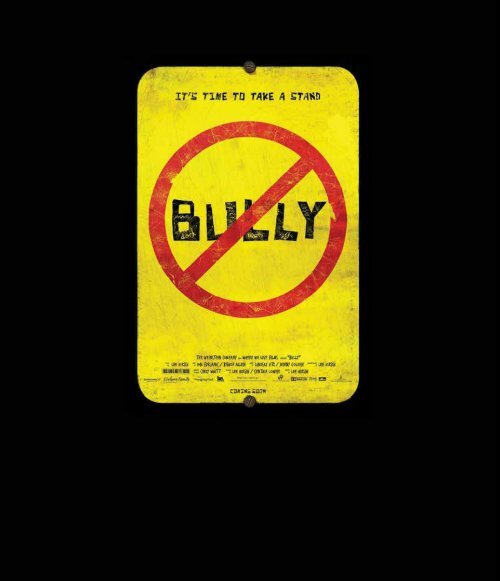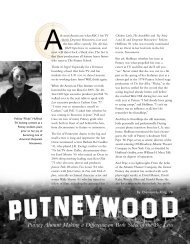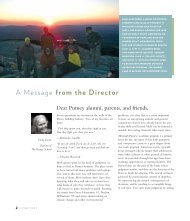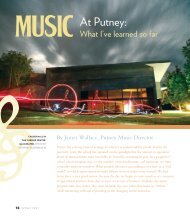14 PutNey PoSt - The Putney School
14 PutNey PoSt - The Putney School
14 PutNey PoSt - The Putney School
Create successful ePaper yourself
Turn your PDF publications into a flip-book with our unique Google optimized e-Paper software.
<strong>14</strong> <strong>Putney</strong> post
Lee Hirsch ’90 on<br />
the Movie and the<br />
Worldwide Movement<br />
By Don Cuerdon<br />
Lee Hirsch ’90 says,<br />
“I remember going to see<br />
Cry Freedom when I was<br />
at <strong>Putney</strong> and it forever<br />
changed my life.” Lee was<br />
an ardent anti-apartheid<br />
advocate in those days and<br />
went on to write and direct<br />
the 2002 film Amandla!<br />
A Revolution in Four Part<br />
Harmony, an awardwinning<br />
documentary<br />
that chronicles the struggle<br />
to end apartheid in South<br />
Africa through the vehicle<br />
of the music that inspired<br />
the participants.<br />
Lee is now crossing the<br />
globe on a monthly basis<br />
with his latest cause, a<br />
much more personal film<br />
that he directed and<br />
co-wrote called Bully that,<br />
as with Amandla!, is so<br />
much more than a movie.<br />
We caught up with him by<br />
phone from Salt Lake City<br />
in January for this look into<br />
his work as both filmmaker<br />
and activist. <br />
PP: How many countries have you been to<br />
promoting Bully?<br />
LH: I feel like I’ve been on an airplane for a year,<br />
non-stop. We’ve been to Australia, South Korea,<br />
New Zealand, Canada, Mexico, Norway—lots<br />
of places.<br />
PP: Tell us about the Bully movement.<br />
LH: I think it’s a fledgling movement. I think<br />
that what’s happening is a broader change in the<br />
landscape. In other words, I think the movie, in<br />
tandem with a lot of efforts that have been going<br />
on, has contributed to what appears to me as a<br />
tipping point, where more and more people from<br />
various walks of life—and not just in America,<br />
but globally—ranging from very progressive<br />
urban communities to very conservative rural<br />
communities have collectively started to say,<br />
“Enough,” and “We have this one wrong,” and<br />
“We need to shift our thinking around this and<br />
<strong>Putney</strong> post 15
Communities have collectively started to<br />
say, “Enough,” and “We have this one<br />
wrong, and “We need to shift of thinking<br />
around this and do that in a public way. . . .<br />
do that in a public way, and start to address<br />
not only the symptoms, but the underlying<br />
causes.” That is a piece of what feels like a<br />
movement. Modern-day movements are hard<br />
to understand. <strong>The</strong> web is much wider. You have<br />
multiple people exercising leadership in various<br />
communities coming up with solutions. That’s<br />
what makes a movement—not Lee Hirsch or<br />
<strong>The</strong> Bully Project.<br />
PP: So the underlying idea of bullying is fairly<br />
constant in all of these countries and cultures<br />
you’ve visited?<br />
LH: Oddly, the reactions of kids and adults are<br />
so incredibly similar. And the stories they tell of<br />
their own experiences are very similar as well.<br />
PP: Amandla! was a different film from Bully<br />
in that it was about something that had already<br />
come to some sort of conclusion. It wasn’t<br />
exactly your fight.<br />
LH: It was the tail end of my fight—the<br />
swan song to my fight. It was something that<br />
consumed me, particularly during my time at<br />
<strong>Putney</strong>. For years it had been my fight and that<br />
[Amandla!] was my “roll it all together and this<br />
is what I made of it” kind of film.<br />
PP: It was a tribute in a lot of ways.<br />
LH: Very much so.<br />
PP: But Bully is not.<br />
LH: I’ve tried to, at least with my documentary<br />
work, make films that are, in their own way, about<br />
social change. <strong>The</strong>y look at the same questions:<br />
What are the drivers? What are the things that<br />
move people off the sidelines? If there’s a thread<br />
to my personal work over the years, it’s that. Both<br />
Amandla! and Bully do that, but they do it in<br />
different ways.<br />
Amandla! examined the idea of a collective,<br />
and how singing and creating energy and spirit<br />
brought people into action and into the struggle<br />
against Apartheid, and sustained them there for a<br />
very, very long time. Bully looks at our attempts<br />
to unlock what is it that would get people to<br />
reevaluate their positions—or rethink or step out<br />
of the box that they’re in, and reach out and be<br />
someone who would stand up for somebody. In<br />
those ways, there is a common thread in the work<br />
in that—at least for me—the internal drive was<br />
about understanding how to fire up engagement.<br />
Bully is obviously a very different film, a very<br />
personal film. It’s a film that I’d been looking<br />
at doing for many, many, many years. Someone<br />
recently reminded me that I was talking about<br />
the film six years ago. I didn’t realize that I had<br />
been carrying it in my pocket quite so long.<br />
16 <strong>Putney</strong> post
It was also a film I was reluctant to make, that<br />
I was scared to make, because of confronting<br />
my own demons and my own past and a lot of<br />
pain that surrounded not just my own narrative,<br />
but all of the people I would come into contact<br />
with, which has been quite intense. A lot of<br />
people reach out and I meet a lot of people in<br />
my travels who are in really hard places. It’s a lot.<br />
But ultimately I think there was a point for me<br />
where it was just time to make that film. That’s<br />
where it was. I felt like the time was right. I had a<br />
producer who wanted to work on it with me and<br />
off we went to the races.<br />
PP: Why is film such a good tool for firing up<br />
that engagement? In the world of Hollywood<br />
entertainment, why would people pay to see<br />
something that’s so much closer to journalism<br />
than escape?<br />
LH: I think good documentaries run the gamut<br />
from personal dramatic stories that unfold very<br />
differently from traditional journalism to more<br />
classic work like that of Ken Burns, for example.<br />
I think Bully is much less a piece of journalism<br />
than it is a very intimate narrative film. When<br />
you’re in Alex’s house with his mom at the<br />
table, that’s as dramatic as any scene in a fiction<br />
film. Amandla! was much more interviews and<br />
construction and archival footage. Some of it<br />
felt like it was unfolding, but it was more of a<br />
journalistic narrative, whereas Bully doesn’t give<br />
you facts or history or underpinnings. <strong>The</strong>re are<br />
no experts in Bully. You’re kind of . . . locked<br />
in a room with these families and these kids<br />
and you’re walking in their shoes. It’s intensely<br />
intimate. Film is an extraordinary medium,<br />
whether you’re creating it for the big screen or<br />
the small screen. This project will have a greater<br />
life, ultimately, on the small screen than it did on<br />
the big screen. Nothing beats the experience of<br />
when we’ve had our screenings for thousands<br />
of kids, for example the 7,000 in Los Angeles.<br />
Nothing beats that experience. So I’m forever<br />
drawn to it because I understand the possibility<br />
of it.<br />
Empty Bowls for Full Stomachs<br />
Empty Bowls is an annual, worldwide event in October that raises hunger<br />
awareness as well as funds to fight hunger. In Brattleboro, the larger town just<br />
south of <strong>Putney</strong>, Empty Bowls is a fundraising event for the Brattleboro Area<br />
Drop-In Center, which provides food, shelter, and other essential resources<br />
to those in need. <strong>Putney</strong> Ceramics Teacher Naomi Lindenfeld has been on<br />
the planning board of Empty Bowls since it started in this area nine and a half<br />
years ago. “I always have students and some adults from <strong>The</strong> <strong>Putney</strong> <strong>School</strong><br />
community make bowls for it,” says Naomi. “I think of it as social justice and<br />
awareness-raising about hunger issues in our community.” For a $25 donation,<br />
guests are served a simple, nutritious meal of soup, bread, cheese, apples,<br />
beverage, and dessert, and enjoy some live music with their meals. Afterwards,<br />
guests are invited to keep the bowls from which they ate as a reminder of the many people who go hungry each day in our<br />
community and beyond. Empty Bowls is made possible by dozens of volunteers ranging from ceramic artists who begin<br />
making bowls early in the summer, to high school students who help serve and clean up on the night of the dinner. Area<br />
businesses and restaurants contribute food, beverages, desserts and supplies, and local professional musicians provide<br />
entertainment. It’s a true community event.<br />
<strong>Putney</strong> post 17
Walking the Walk: Action on Martin Luther King, Jr. Day<br />
For much of the United States, Martin Luther King, Jr. Day is a day off. Not<br />
so at <strong>The</strong> <strong>Putney</strong> <strong>School</strong>. “We are walking the walk,” says Janine Hamilton<br />
’73, who teaches theater arts, visual arts, and sits on the board of trustees as a<br />
faculty representative. Janine organized a full day of workshops and community<br />
service work for the school community to participate in. This year’s workshops<br />
were entitled Guerrilla Sing, Madrigals, Spoken Word, Weaving for Rwanda,<br />
Printmaking for Rwanda, Exploring the Challenges of Local Hunger, Pink Slip<br />
Bowl Project, Social Justice, Adrian Piper, Video, Contemporary Slavery, Having Difficult Conversations, Alex’s Haley’s<br />
Interview of George Lincoln Rockwell, <strong>The</strong> World Needs More Love Letters, White Privilege, Gender Alliance, Awkward<br />
Turtle: <strong>The</strong> Art of Difficult Conversations, and Implicit Racism: What it is to Be Offensive Without Realizing It. In the<br />
afternoon, students and faculty went out into the community to do service projects ranging from preparing Meals on<br />
Wheels to singing in retirement homes.<br />
PP: What else has been born of the movie?<br />
LH: Do you know about the work that we’ve<br />
done with <strong>The</strong> Bully Project campaign that<br />
I’ve created—that we’ve, with the Million Kids<br />
movement [ed. note: a campaign to have one million<br />
children see the film and do the prescribed course work<br />
with their schools], engaged over a quarter of a<br />
million kids across the country? It’s an amazing<br />
program through which we were able to enroll<br />
many schools from across the board—and these<br />
are all public schools—Salt Lake City, Cleveland,<br />
Cincinnati, San Francisco.<br />
PP: Who is <strong>The</strong> Bully Project? Is it just you?<br />
LH: <strong>The</strong> Bully Project is Lee Hirsch, Sarah<br />
Foudy [’90], also from <strong>The</strong> <strong>Putney</strong> <strong>School</strong>, who<br />
is the campaign director and has been working<br />
with us for over a year, and about six other<br />
people. It’s a small, but really effective, grass-roots<br />
team. We have an office in New York City. We’ve<br />
been working on both [promoting the film and<br />
the Million Kids movement], which is really a<br />
huge effort in terms of being able to facilitate<br />
and raise the dollars as well. We’ve raised millions<br />
of dollars for the campaign at this point. All of<br />
it went into creating these opportunities for<br />
communities across the country. I’m really proud<br />
of that. Our next phase is about to launch, which<br />
is the consumer DVD, but also an educator’s box<br />
kit with the film and the tools we built, and the<br />
guides, the webinars, the principals’ pledges, and<br />
the resources we’ve created together with Harvard<br />
on how to create a more caring community in<br />
the school—to increase emotional and social<br />
competency. We’re finding that we’re able to<br />
market these innovative ideas effectively through<br />
the vehicle of the film. That’s a lot of our work.<br />
PP: What kind of a future are you trying to<br />
create with all of this?<br />
LH: It’s interesting to imagine impact. <strong>The</strong>re are<br />
times when you think about this bigger societal<br />
shift that’s happening—genuinely being a part<br />
of that shift and trying to catalyze it. And then<br />
there are times when you focus down on the<br />
18 <strong>Putney</strong> post
one family you just talked to that had a really<br />
transformative experience, or the group of kids<br />
who have just written you because they’ve<br />
launched a new project about changing school<br />
culture and standing up for other kids, and it’s<br />
innovative, and it’s smart, and they’re on fire with<br />
it. Or it’s as simple as looking at Alex [one of the<br />
children bullied in Bully] and how his life has<br />
been transformed. At different times I think about it<br />
all in different ways. I’m very proud of the impact<br />
that the film has had and will continue to have.<br />
And, hopefully, if we’ve done our jobs right, it’s<br />
not dependent on me. We’ve given resources and<br />
inspiration and guidance to thousands of people<br />
who have launched their own little movements<br />
and led their own initiatives. And that will<br />
hopefully carry on and be the legacy of this film.<br />
And I will move on and make other films that<br />
may or may not be about changing the world<br />
or have social relevancy. I might want to do<br />
a comedy next. I feel like it’s time to make a<br />
career shift.<br />
PP: What does your near future look like?<br />
LH: In the last three days I’ve been in New York,<br />
California, North Carolina, and now Utah. Two<br />
days from now I’ll be in DC, and then New York,<br />
and then Seattle six days from today. It’s a lot<br />
of travel.<br />
PP: What about 500 years hence? What if we<br />
have political leaders who aren’t bullies? Bankers<br />
who aren’t bullies? Teachers who aren’t bullies?<br />
LH: When I talk about the tipping point, I often<br />
reference something like drinking and driving<br />
where, 30 or 40 years ago, it was accepted. It was<br />
an inevitability. And today, by and large, people<br />
don’t do it and they feel really bad if they do.<br />
I think that’s the kind of transformation that<br />
will happen around bullying—that this is the<br />
generation that will step up and say, “We did that<br />
one in. Public opinion shifted so greatly that it<br />
was no longer acceptable. It will no longer give<br />
you the sort of social currency that it used to.<br />
And so, by that nature, its own fire burned out.”<br />
That’s what I hope to shape.<br />
<strong>Putney</strong> post 19
<strong>Putney</strong> Sees Bully<br />
Alumni Relations Manager Alison Frye rented<br />
the Bellow Falls Opera House for a showing of<br />
Bully last September, to which we invited several<br />
other local schools, including the Greenwood<br />
<strong>School</strong>, Vermont Academy, and Kurn Hattin<br />
Homes. Formal conversations around the movie<br />
occurred during dorm meetings that evening,<br />
but much more was discussed in many<br />
conversations since.<br />
As Lee Hirsch ’90 has mentioned, the movie<br />
brings up feelings for people who have been<br />
bullied or witnessed bullying. Cameron, a <strong>Putney</strong><br />
<strong>School</strong> senior, spent her freshman year of high<br />
school in a place that was, as she describes it,<br />
much different from <strong>Putney</strong>. She witnessed her<br />
brother’s senior year of high school there.<br />
“My brother is 21 now,” says Cameron. “He has<br />
pretty severe learning differences that have caused<br />
him to be bullied his entire life. He’s partially<br />
bi-polar and has permanent frontal lobe damage,<br />
which causes him to sometimes not be able<br />
to control what he says. His tongue is partially<br />
paralyzed so he’s had a speech impediment his<br />
whole life.”<br />
About watching Bully with us for the first time,<br />
Cameron says, “I felt like I could put my brother<br />
in that movie. I could relate to it in every way. I<br />
could easily put myself in all of those situations.<br />
<strong>The</strong> bus is the hellhole of high school. It’s worse<br />
than the hallways.”<br />
“People would purposely say something to my<br />
brother and he would say something back that<br />
was obviously a little off—his way of thinking<br />
is completely different. And someone would<br />
say, ‘You’re stupid! You’re a retard!’—all of these<br />
words that make me so angry. And the kids would<br />
say, ‘Mr. Chambers! Mr. Chambers! Chris said<br />
blah, blah, blah!’ And then he [her brother, Chris]<br />
wouldn’t be able to ride the bus for a week.”<br />
20 <strong>Putney</strong> post
“When I look at where I am right now, and<br />
have been for the past three years, I wish my<br />
brother were in my place sometimes. . . . I<br />
find boarding school to be safe—at least<br />
<strong>The</strong> <strong>Putney</strong> <strong>School</strong>.”<br />
It’s no time to sit back our laurels. Existing in<br />
an environment where bullying is unwelcome<br />
will remain a moving target, like racism, sexism,<br />
and many other social ills. As Lee Hirsch<br />
says, “It’s a place that’s hard-sought.” We will<br />
continue seeking it.<br />
Reflections on the<br />
Rise of Concern<br />
About Bullying<br />
Lee Combrinck-Graham ’59, M.D.<br />
Adult, Child, Adolescent,<br />
and Family Psychiatrist<br />
Medical Director, FSW, Inc.,<br />
Bridgeport, CT<br />
Bullying is a topic that has occupied headlines<br />
with increasing frequency in the last 20 years.<br />
Bullying is a behavior described as oppression<br />
(physical or emotional) of the weaker by the<br />
more powerful. It is quintessentially about<br />
status, the bullies attempting to establish and<br />
maintain their sense of status by degrading and<br />
overwhelming the bullied. Understanding more<br />
about how status is achieved and maintained<br />
among children may illuminate the rise of<br />
bullying and offer more effective ways<br />
of maintaining social contexts that do<br />
not foster bullying.<br />
Bullying may begin in a family, when there<br />
is domestic violence, and can become<br />
internalized by the children as a model<br />
for conducting interpersonal relationships.<br />
But bullying behavior usually emerges in<br />
school. <strong>The</strong> school experience ushers in a<br />
developmental phase that is more focused<br />
on social behavior and peer interaction than<br />
earlier in children’s experiences. Harry Stack<br />
Sullivan, a quirky and influential psychiatrist,<br />
the original interpersonal psychiatrist, once said<br />
that going to school is the first opportunity<br />
that society has to correct the influence of the<br />
family on the growing youngster. Erik Erikson<br />
characterized the fourth stage in his eight stages<br />
of man, the stage of the school-aged child, as<br />
the focus on industry versus inferiority, the<br />
stage at which the child begins to learn the<br />
“industry” of his or her society. Among<br />
the many ways that Jean Piaget characterized<br />
the developments of the Concrete Operational<br />
Stage of logical development, that stage<br />
occurring during the school age period, was<br />
the capacity to take another’s point of view.<br />
Each of these observations about children’s<br />
development when they go to school clearly<br />
highlights the importance of education not<br />
simply to be mastering academics, but as<br />
learning how to be a member of society.<br />
Policies that focus on standardized test<br />
performance and “No Child Left Behind”<br />
painfully assort effective students (from the<br />
performance standpoint) from less successful<br />
students, drawing attention to differences that<br />
become exaggerated, even though they should<br />
be irrelevant to children’s standing in the<br />
society of their peers.<br />
Respect is fundamental to a functioning<br />
society, and the classification of children<br />
according to their performance assigns respect<br />
and, therefore, status, to those who perform<br />
well. Those who perform less well may deal<br />
with their status problem either by suffering<br />
or by using “brute” strength to compensate<br />
for their feelings of inferiority. This seems to<br />
be the basis of bullying. <strong>The</strong> fact that bullying<br />
occurs in a social context where respect and<br />
self-respect are not adequately identified,<br />
recognized, and valued, is often being missed.<br />
Bullying is about status, fighting for status, and<br />
claiming status by “demoting” others. And sadly,<br />
everyone in the system becomes absorbed in<br />
the threatening or fearful process of bullying.<br />
Bullying is not simply a one-sided oppression<br />
of the weaker. <strong>The</strong> bullied individuals are<br />
also involved in the bullying cycle, often by<br />
attempting to gain the respect of the bullies,<br />
and often in a way that actually incites more<br />
dramatic bullying behaviors. Children with<br />
<strong>Putney</strong> post 21
Greg Pierotti of<br />
Tectonic <strong>The</strong>ater<br />
Project <strong>The</strong><br />
<strong>Putney</strong> <strong>School</strong> cast of<br />
<strong>The</strong> Laramie Project<br />
Ten Years Later;<br />
<strong>The</strong> <strong>Putney</strong> <strong>School</strong> cast<br />
of <strong>The</strong> Laramie Project<br />
various disabilities seem to be more likely to be<br />
bullied. For example, in their efforts to impress the<br />
bullies, youngsters with Asperger’s disorder may<br />
display some part of their knowledge that has the<br />
opposite effect. One youngster responded to his<br />
bullies by quoting Chaucer in Middle English.<br />
Many parents I have seen who believe their children<br />
are being bullied find that the teachers and other<br />
school personnel are unresponsive and unhelpful.<br />
<strong>The</strong>y cannot intervene, they say. <strong>The</strong>y have not<br />
witnessed the actual bullying; they cannot take one<br />
child’s story against another, and so on. It seems<br />
that in some ways school personnel become bullied<br />
by their own limitations to intervene. Parents<br />
become angry. Parents of the bullies become angry<br />
and bullying as they stand by their children. This<br />
moving from one side to another tends to result<br />
in escalation, not just of the bullying but also of<br />
the reaction of the bullied, who may make more<br />
pronounced efforts to get positive attention from<br />
the bullies, or alternatively, to become more pathetic<br />
and weak, usually spurring the bullies to further<br />
bullying. Ironically, almost any response of<br />
the bullied can aggravate bullying, and so the<br />
cycle escalates.<br />
Saying “no” to bullying is similar to saying “no”<br />
to drugs. It begs the question of what we should<br />
be saying “yes” to.<br />
I believe we should be saying “yes” to recognition<br />
and respect of individuals’ responsibility and<br />
participation in their communities. Both bullies<br />
and the bullied need to have their attributes and<br />
gifts recognized and embraced, perhaps beginning<br />
at home, but definitely celebrated in their school<br />
communities. Recognition and respect mean a<br />
culture that acknowledges differences, recognizes<br />
them, and values them. It means a school culture<br />
of collaboration among students as well as among<br />
students and teachers. <strong>The</strong>re are many models that<br />
seem to have worked over time, but these models<br />
have been difficult to employ when the emphasis<br />
on achievement prevails.<br />
Garrison Keillor describes Lake Wobegon, where<br />
“all the children are above average.” When all the<br />
children are above average, then all the children<br />
have the respect of each other and their teachers<br />
and parents in their communities. Bullying has<br />
no place in such a society.<br />
Social Justice<br />
<strong>The</strong>ater: <strong>The</strong><br />
Laramie Project<br />
<strong>The</strong> fall plays performed at the end of Project<br />
Week last fall were <strong>The</strong> Laramie Project by Moisés<br />
Kaufman and the members of Tectonic <strong>The</strong>ater<br />
Project and <strong>The</strong> Laramie Project: Ten Years Later<br />
by Moisés Kaufman, Leigh Fondakowski, Greg<br />
Pierotti, Andy Paris, and Stephen Belber. Both<br />
are very difficult shows to perform because<br />
each actor plays several characters who change<br />
on stage. <strong>The</strong> transitions are critical to the story<br />
telling. Our casts were extremely fortunate that<br />
one of our student cast members, Danny ’<strong>14</strong>,<br />
is a family friend of Greg Pierotti, an author/<br />
character in the plays, and that Greg was willing<br />
to spend the time to help us get it right.<br />
In October of 1998, Greg was the first to<br />
arrive, with Tectonic <strong>The</strong>ater Project colleague<br />
Leigh Fondakowski, on the scene in Laramie,<br />
Wyoming, just days after Matthew Shepard had<br />
been murdered. Picking up where the sensationdriven<br />
media left off, Greg and the other authors<br />
went searching for the deeper truth of the crime.<br />
<strong>The</strong>ater has long been a vehicle for examining<br />
social justice and these plays do just that.<br />
Greg visited <strong>The</strong> <strong>Putney</strong> <strong>School</strong> last semester<br />
and worked with both casts on “Moment<br />
Work,” a specialty of Tectonic <strong>The</strong>ater Project<br />
that is essential to both plays’ transitions. He also<br />
presented to the entire school in assembly on<br />
what it was like to wade into the hotbed<br />
of emotion that was Laramie, Wyoming, in<br />
October 1998, and what it was like to return<br />
and interview the crime’s perpetrators, among<br />
others, ten years later.<br />
Greg was in the audience here at the Jeffrey<br />
Campbell <strong>The</strong>ater for one of each performance<br />
because <strong>The</strong> Laramie Project is an ongoing concern<br />
for him and an excellent tool for social justice<br />
education. Learning about what happened never<br />
really ends.<br />
22 <strong>Putney</strong> post
Social Justice<br />
Modern Dance:<br />
Lynchtown<br />
Nimbus Dance Works, of Jersey City, New<br />
Jersey, took up residency with us last spring as<br />
they tuned up their 2012 season, including a<br />
collaborative modern dance piece called “Memo,”<br />
which featured many members of <strong>The</strong> <strong>Putney</strong><br />
<strong>School</strong> dance ensemble and extended community.<br />
This year they’re back to work with us on Charles<br />
Weidman’s Lynchtown (1936), which is recognized<br />
as one of the classic works of American modern<br />
dance and a prime example of dance as a medium<br />
for socio-political expression and protest. Known<br />
for its vivid depiction of a crazed mob at the point<br />
of carrying out a lynching, Lynchtown was created<br />
by Weidman in response to witnessing a lynching<br />
in his home community of Lincoln, Nebraska,<br />
as a child at the turn of the century. Nimbus<br />
Dance Works will present a staging of Lynchtown<br />
in partnership with the Charles Weidman Dance<br />
Foundation. Additionally, Samuel Pott (son of Jay<br />
Goodwin Pott ’62) will choreograph a new dance<br />
that examines some of the same thematic material<br />
as Lynchtown from a contemporary perspective. Sam<br />
is also working with <strong>Putney</strong> <strong>School</strong> dance teacher,<br />
Jonathan Riseling, to develop a complementary<br />
piece of our own. A version of <strong>Putney</strong>’s original<br />
piece was presented by our dance ensemble as<br />
a work in progress when Nimbus Dance Works<br />
visited last October. <strong>The</strong> final work was performed<br />
on February 15 in Calder Hall of the Michael<br />
S. Currier Center. Pictured here are our dancers<br />
working with members of Nimbus Dance<br />
Works last fall.<br />
Social Justice Literature:<br />
Senior Seminar<br />
Senior seminars in English are opportunities to take<br />
advantage of our faculty’s deeper knowledge—<br />
beyond the nuts and bolts of grammar, composition,<br />
and the other tools we learn in the lower grades.<br />
Juan Rodriguez teaches Social Justice Literature<br />
because it’s what he loves. And his students elect<br />
to take the course because Juan loves what he’s<br />
teaching and encourages them to explore the<br />
subject with him. Last fall they read I, Rigoberta<br />
Menchú: An Indian Woman in Guatemala, a Nobel<br />
Prize-winner in which Menchú describes the<br />
virtual enslavement of her people, the Quiché<br />
Indians, by the United Fruit Company in the late<br />
1960s and early ’70s, for the purpose of producing<br />
fruit inexpensively to be sold at a great profit<br />
in the United States. <strong>The</strong> book focuses on how<br />
the Quiché maintained their cultural identity by<br />
intentionally rejecting the culture of their “ladino”<br />
adversaries, and thereby strengthening Quiché<br />
culture. It’s a complicated, beautiful, horrible story of<br />
triumph in adversity—and a lesson worth learning.<br />
<strong>The</strong> class stands on its own by virtue of the subject<br />
matter and Juan’s expertise. But there’s much more<br />
to the story. Students at <strong>The</strong> <strong>Putney</strong> <strong>School</strong> hail<br />
from 26 states and <strong>14</strong> foreign countries, including<br />
four students in Social Justice Literature born and<br />
raised in China. Imagine an English teacher of<br />
Mexican descent discussing the life and times of<br />
a Quiché Indian woman with students from the<br />
United States and China in a high school classroom<br />
situated on a bucolic hillside in rural Vermont and<br />
you’ll just begin seeing how deep a diverse, yet<br />
finely focused, educational experience can go.<br />
<strong>Putney</strong> post 23

















